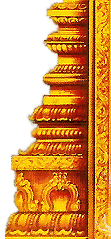| |
|
|
 | Singers: |  |
| |
|
|
| |
- |
|
| |
|
|
 |
Festival: |
 |
| |
|
|
| |
Srirama Navami in March-April; Hanuman Jayanthi; Margazhi worship during the whole month in December-January and Navarathri in September-October are the festivals celebrated in the temple. |
|
| |
|
|
 |
Temple's Speciality: |
 |
| |
|
|
| |
During the celebration of the Muthu Pandal Utsav in Patteeswaram Thenupreeswarar temple to honour Gnana Sambandar, the child saintswould visit the Kodhandaramaswami temple also. The Silk Shawl used for Perumal Alankara would be offered to the saint as a courtesy. This event is still followed in both temples here. |
|
| |
|
|
 |
Opening Time: |  |
| | | |
| |
The temple is open from 6.00 a.m. to 10.00 a.m. and from 5.00 p.m. to 8.00 p.m. |
|
| | | |
 |
Address: |  |
| | | |
| |
Sri Kodhanda Ramaswami Temple, Patteeswaram-612 703. Kumbakonam Taluk, Thanjavur district. |
|
| | | |
 |
Phone: |  |
| | | |
| |
+91 435-241 6976 | |
|
| | |
 |
General Information: |  |
| |
|
|
| |
Passing the three tier Rajagopuram, is the spacious Mahamandap built on the Vavathri style with Garuda Bhagwan, flagpost-Kodimaram, kitchen and the temple office. With Jaya and Vijaya as the Dwarapalakas-security, Lord Kodhanda Ramar appears mercifully from the sanctum sanctorum with Mother Sita, Lakshmana and Sri Anjaneya facing east. There are also shrines in the temples for Vaishnavite Acharyas Sri Ramanuja and Manavala Mamunigal. |
|
| |
|
|
 |
Prayers |  |
|
|
| |
| |
Majority of the devotees are those in the silk weaving trade. | |
|
|
| |
 |
Thanks giving: |  |
|
|
| |
| |
They perform abishek to Lord Kodhandarama and light ghee lamps in the shrine. | |
| |
| |
 |
Greatness Of Temple: |  |
| |
|
|
| |
Sage Shaliar was one among the Maharshis meeting Rama. Shaliar was known as Pattu Shalia Maharshi as he was in the silk weaving trade. Pattu in Tamil means Silk. Silk weavers always bore a dosha as they had to kill numerous silk worms in their profession. The Sage wanted to protect them from dosha. He worshipped Lord Rama in this temple. Pleased with his bhakti, Lord asked the sage for his wish. The sage said that his community should be saved from the dosha of killing the silk worms which was unavoidable in the profession. He also prayed to the Lord to stay in this place itself so that the weavers could worship Him daily. Lord granted the boons sought by the Rishi and stayed here. |
|
| |
|
|
 |
Temple History: |  |
| |
|
|
| |
Every one in India and also in other countries know the story of Ramayana. It is the story of Lord Vishnu as a Human Rama suffering all the hardships natural in human life, common and very serious in nature during the life time. He did not use his divine powers to kill Ravana but followed the procedures enacted by scriptures. Making friends with Sugriva, he invaded Lanka with a large army to rescue Mother Sita abducted by Ravana. As all truce efforts failed, the war happened and ended with the killing of Ravana. Yet, Lord had to bear the many doshas that would fall on him for killing Ravana a Brahmin, a Lord Shiva devotee, a brilliant warrior and an artist. Rama had to suffer both Veerahati and Brahmmahati doshas.
Lord performed Shiva Puja in Rameswaram with a Linga and theertha He created and got relieved of the Brahmmahati dosha. For relief from the Veerahati dosha, Lord performed Shiva Puja in Vedaranyam where Vedas worshipped Lord Shiva. With a bath in the sea here, he got relieved of the Veerahati dosha. And for the third, Shayahati dosha, Lord Rama came to this place, Patteeswaram. He chose a place on the southern banks of Surya, Soma Kamala Pushkarani of Arasalaru and meditated on Lord Shiva. Here too, He created a theertha and performed abishek to Lord Shiva and thus got relieved of all the doshas caused by killing Ravana. Devas rained flowers on the Lord, Sages worshipped Him with teir wives-Pathnis. |
|
| |
|
|
 |
Special Features: |  |
| |
|
|
| |
Miracle Based:
During the Muthu Pandal utsav in Thenupureeswarar temple celebrated to honour Saint Gnanasambandar in Aani month (June-July), the saint visits Kodhanda Ramaswami temple also when the silk shall of Lord is offered to saint as a courtesy. This event is celebrated in both temples even today.
|
|
| |
|
|
|
| |
|
|





